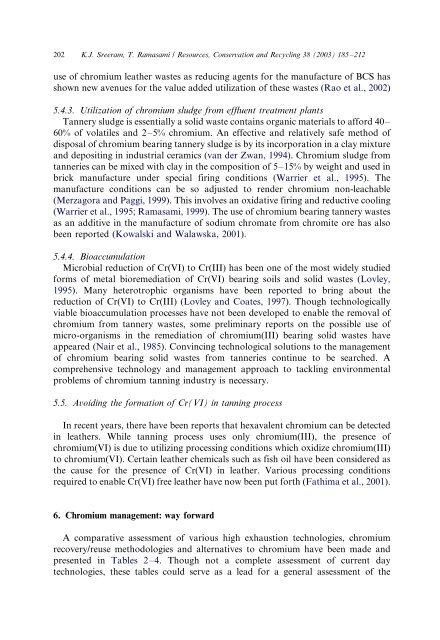chromium tanning.pdf - ChangeandLeadershipGroupAssignment
chromium tanning.pdf - ChangeandLeadershipGroupAssignment
chromium tanning.pdf - ChangeandLeadershipGroupAssignment
Create successful ePaper yourself
Turn your PDF publications into a flip-book with our unique Google optimized e-Paper software.
202<br />
K.J. Sreeram, T. Ramasami / Resources, Conservation and Recycling 38 (2003) 185 /212<br />
use of <strong>chromium</strong> leather wastes as reducing agents for the manufacture of BCS has<br />
shown new avenues for the value added utilization of these wastes (Rao et al., 2002)<br />
5.4.3. Utilization of <strong>chromium</strong> sludge from effluent treatment plants<br />
Tannery sludge is essentially a solid waste contains organic materials to afford 40 /<br />
60% of volatiles and 2 /5% <strong>chromium</strong>. An effective and relatively safe method of<br />
disposal of <strong>chromium</strong> bearing tannery sludge is by its incorporation in a clay mixture<br />
and depositing in industrial ceramics (van der Zwan, 1994). Chromium sludge from<br />
tanneries can be mixed with clay in the composition of 5 /15% by weight and used in<br />
brick manufacture under special firing conditions (Warrier et al., 1995). The<br />
manufacture conditions can be so adjusted to render <strong>chromium</strong> non-leachable<br />
(Merzagora and Paggi, 1999). This involves an oxidative firing and reductive cooling<br />
(Warrier et al., 1995; Ramasami, 1999). The use of <strong>chromium</strong> bearing tannery wastes<br />
as an additive in the manufacture of sodium chromate from chromite ore has also<br />
been reported (Kowalski and Walawska, 2001).<br />
5.4.4. Bioaccumulation<br />
Microbial reduction of Cr(VI) to Cr(III) has been one of the most widely studied<br />
forms of metal bioremediation of Cr(VI) bearing soils and solid wastes (Lovley,<br />
1995). Many heterotrophic organisms have been reported to bring about the<br />
reduction of Cr(VI) to Cr(III) (Lovley and Coates, 1997). Though technologically<br />
viable bioaccumulation processes have not been developed to enable the removal of<br />
<strong>chromium</strong> from tannery wastes, some preliminary reports on the possible use of<br />
micro-organisms in the remediation of <strong>chromium</strong>(III) bearing solid wastes have<br />
appeared (Nair et al., 1985). Convincing technological solutions to the management<br />
of <strong>chromium</strong> bearing solid wastes from tanneries continue to be searched. A<br />
comprehensive technology and management approach to tackling environmental<br />
problems of <strong>chromium</strong> <strong>tanning</strong> industry is necessary.<br />
5.5. Avoiding the formation of Cr(VI) in <strong>tanning</strong> process<br />
In recent years, there have been reports that hexavalent <strong>chromium</strong> can be detected<br />
in leathers. While <strong>tanning</strong> process uses only <strong>chromium</strong>(III), the presence of<br />
<strong>chromium</strong>(VI) is due to utilizing processing conditions which oxidize <strong>chromium</strong>(III)<br />
to <strong>chromium</strong>(VI). Certain leather chemicals such as fish oil have been considered as<br />
the cause for the presence of Cr(VI) in leather. Various processing conditions<br />
required to enable Cr(VI) free leather have now been put forth (Fathima et al., 2001).<br />
6. Chromium management: way forward<br />
A comparative assessment of various high exhaustion technologies, <strong>chromium</strong><br />
recovery/reuse methodologies and alternatives to <strong>chromium</strong> have been made and<br />
presented in Tables 2 /4. Though not a complete assessment of current day<br />
technologies, these tables could serve as a lead for a general assessment of the


